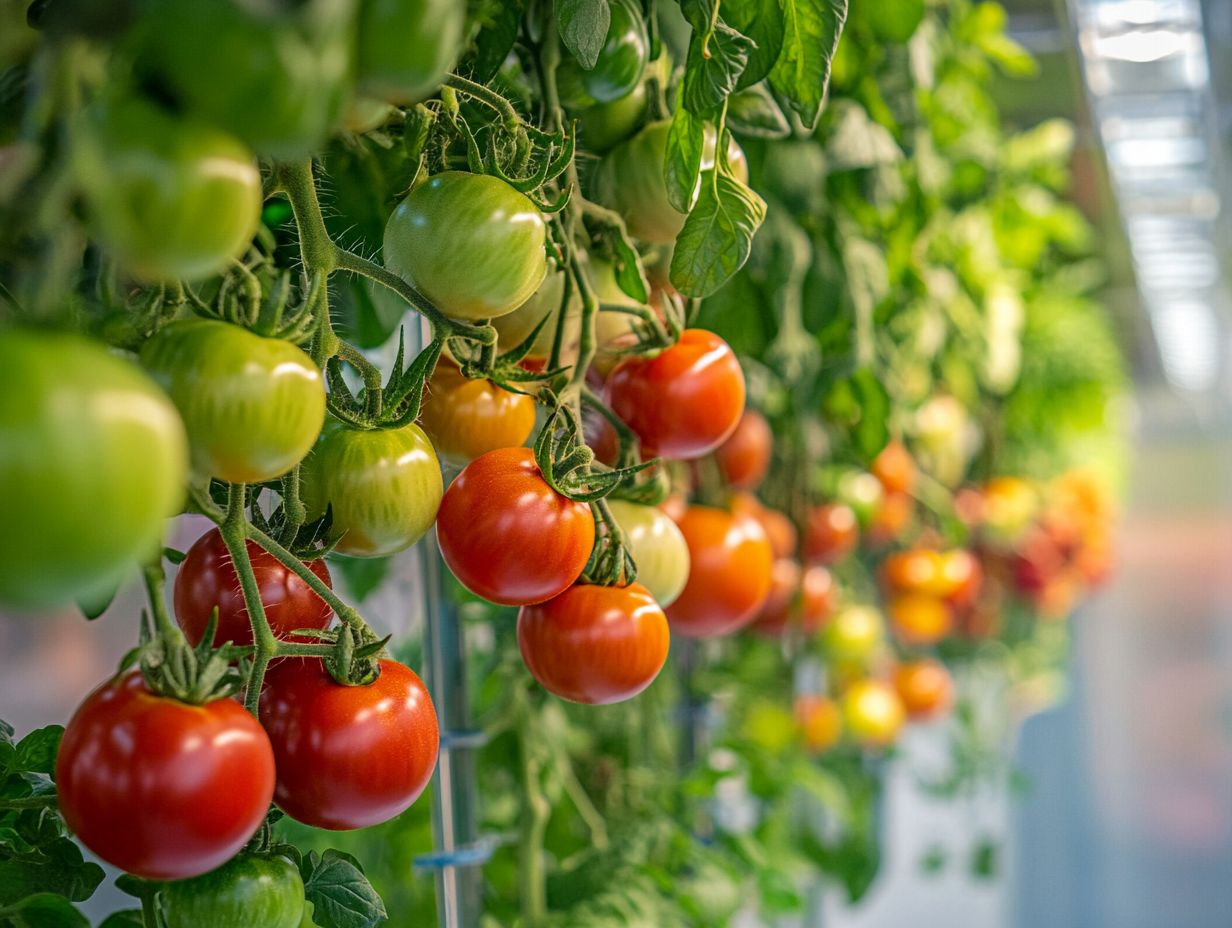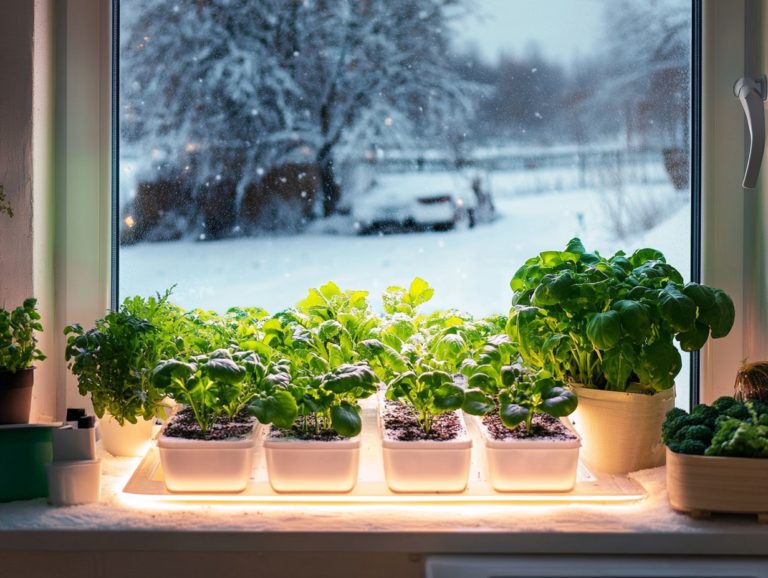“Hydroponic Gardening: Must-Try Tomato Varieties”
Hydroponic gardening is changing how we grow food. It offers a soil-less option that boosts yield and efficiency.
Among the multitude of plants you can cultivate, tomatoes stand out as a favorite for hydroponic enthusiasts.
This article delves into the benefits of growing tomatoes hydroponically. It showcases the top varieties that thrive in this method and offers practical tips for achieving optimal growth.
Whether you re an experienced gardener or just starting out, you ll find valuable insights to elevate your tomato-growing efforts with hydroponics!
Contents
- Key Takeaways:
- Benefits of Growing Tomatoes Hydroponically
- Choosing the Right Tomato Varieties
- Top Tomato Varieties for Hydroponic Gardening
- Tips for Successful Hydroponic Tomato Growing
- Common Issues and How to Address Them
- Frequently Asked Questions
- Can I grow tomatoes using hydroponic gardening?
- What are some must-try tomato varieties for hydroponic gardening?
- Do I need any special equipment for hydroponic tomato gardening?
- What are the benefits of growing tomatoes in a hydroponic system?
- Can I grow organic tomatoes using hydroponic gardening?
- Are there any challenges to growing tomatoes in a hydroponic system?
Key Takeaways:

- Boost your garden’s yield and speed with hydroponic tomatoes.
- Choose disease-resistant varieties for the best results.
- Keep an eye on nutrients, light, and temperature for healthy growth.
What is Hydroponic Gardening?
Hydroponic gardening is a cutting-edge method that allows you to grow plants without soil, using water mixed with plant food to deliver essential elements for development.
This sustainable practice enables year-round cultivation and is particularly well-suited for crops like tomatoes, including charming dwarf varieties such as Venus Micro Dwarf and Micro Tom.
By optimizing space and resources, you can enjoy a thriving garden. With technological advancements, systems like Aerogarden and Idoo make hydroponics accessible for both home gardeners and commercial growers.
These systems ensure healthier plants with reduced disease risks in a controlled environment, which is crucial for preventing root rot.
At its core, hydroponic gardening emphasizes efficient nutrient uptake and water conservation.
By eliminating the need for traditional soil, this method not only accelerates growth rates but also minimizes the threat of soil-borne pests and diseases.
There are various hydroponic systems available, such as:
- Deep Water Culture: Plant roots are suspended in a nutrient solution that promotes oxygen saturation.
- Nutrient Film Technique (NFT): A thin film of nutrient solution circulates over the roots.
- Kratky Method: A passive system that requires minimal inputs, ideal for beginners.
By exploring these diverse approaches, you can uncover the best fit for your specific gardening goals.
Benefits of Growing Tomatoes Hydroponically
Growing tomatoes hydroponically presents you with an array of advantages, from remarkably higher yields to exceptional flavor quality.
This makes it an enticing choice for both hobbyists and commercial growers alike. By employing methods like Deep Water Culture or automated systems, you can manipulate environmental factors like light sources and nutrient solutions.
This control fosters faster growth and healthier plants that are notably more resistant to diseases than those grown in traditional soil.
Get ready to grow your favorite crops all year round with this exciting method! It enables you to cultivate crops year-round thanks to controlled environments offered by Aerogarden, particularly during off-seasons.
This elevates both productivity and flavor quality to new heights.
Higher Yields and Faster Growth
Hydroponic systems are crafted to create the best conditions for plants. This enables you to achieve higher yields and faster growth rates compared to conventional farming methods.
This innovative approach grants you precise control over plant food, ensuring that your plants receive exactly the right amount of water and minerals needed for vigorous growth.
For instance, in a well-managed hydroponic farm, you can witness lettuce growing up to 30% faster than in soil-based systems, with yields soaring to nearly 10 times greater per square foot. You can operate these systems indoors or in greenhouses, allowing you to manipulate environmental factors such as light, temperature, and humidity, creating the perfect growing environment all year long!
Research lends weight to this method; hydroponically grown tomatoes, for example, can yield nearly double the harvests within the same timeframe compared to traditional soil methods. This showcases the remarkable efficiency and potential of this cultivation technique, especially when utilizing top-tier plant food like those provided by brands such as Masterblend and Calcium Nitrate.
Choosing the Right Tomato Varieties

Selecting the right tomato varieties is essential for your success in hydroponic gardening, especially when you consider the unique traits of dwarf tomatoes like Venus Micro Dwarf and Tiny Tim.
These compact varieties are ideal for tight spaces and indoor systems. They truly excel in hydroponic setups, taking full advantage of the controlled conditions that hydroponics offers think optimized plant food and tailored light sources.
By grasping the specific growth requirements and yield potential of each variety, including dwarf tomatoes, you ll be well-equipped to make informed choices that enhance both production and flavor quality.
Determining Factors for Hydroponic Tomatoes
When you’re growing hydroponic tomatoes, several key factors come into play, including your light source, plant food, and the overall design of your growing system, which must be chosen to fit the specific needs of your tomato varieties.
Each of these components is essential for the health and productivity of your plants. For instance, optimal light source conditions typically involve using full-spectrum LED lights. These not only provide the necessary wavelengths for photosynthesis but can also be adjusted in duration and intensity depending on the stage of growth your tomatoes are in, especially for fast-growing varieties.
Similarly, your plant food needs to be carefully formulated, ensuring it has adequate levels of essential elements like nitrogen, phosphorus, and potassium. Utilizing monitoring tools such as pH meters and EC meters will help you maintain these optimal levels, allowing you to make adjustments as necessary for healthy growth. An EC meter measures the electrical conductivity of a solution, giving you insight into nutrient concentration.
The design of your growing system also plays a significant role in air circulation and root health. Regularly assessing and modifying your setup is crucial to support robust tomato development and maximize your yield, while also preventing issues such as root rot.
Top Tomato Varieties for Hydroponic Gardening
In hydroponic gardening, choosing the right tomato varieties can significantly elevate your growing experience and yield. Varieties like Micro Tom, Venus Micro Dwarf, and Tiny Tim are especially well-suited for hydroponic systems, thriving in controlled environments and delivering delicious fruit.
These compact tomatoes not only maximize your space but also give you the chance to grow tomatoes indoors or in restricted outdoor areas, allowing you to enjoy high-quality produce throughout the year, especially when utilizing optimal plant food.
Start your hydroponic adventure today and enjoy fresh tomatoes at home!
Features and Characteristics of Each Variety
Understanding the features and characteristics of each tomato variety is essential for your success in hydroponic growing. These elements directly influence both flavor quality and disease resistance.
By selecting the right type, you can optimize your yield and ensure that your plants thrive in a soilless environment. Popular hydroponic tomato varieties, such as ‘Cherry,’ ‘Beefsteak,’ and ‘Roma,’ each boast unique sizes, ranging from bite-sized morsels to substantial, meaty fruits. The flavor profiles also vary, offering sweet, tangy, or rich notes to cater to your culinary needs.
Growth conditions are crucial for the performance of each variety. This includes light requirements, nutrient levels, and pH balance. Be mindful of common diseases like powdery mildew and blossom end rot, which can present challenges. Implementing preventive measures, such as ensuring proper airflow and conducting regular monitoring, can significantly enhance the health of your plants.
Tips for Successful Hydroponic Tomato Growing

Follow these essential best practices to watch your tomatoes thrive! This includes mastering the art of pruning tomatoes, diligently monitoring nutrient levels, and leveraging automatic systems for efficient watering and feeding.
Implementing these strategies will set you up for a thriving tomato harvest.
Key Factors for Optimal Growth and Yield
Key factors for ensuring optimal growth and yield in hydroponic gardening center around carefully managing your nutrient mix, precise environmental control, and thoughtful variety selection. This includes the right light source for different stages of growth.
To achieve the finest results, pay close attention to elements such as light intensity and spectrum, which can greatly impact photosynthesis in your hydroponic tomatoes. Controlling the temperature within the ideal range of 70-85 F, while maintaining humidity levels between 50-70%, is crucial for preventing diseases and promoting healthy growth.
A proper nutrient balance is equally vital. Utilizing advanced systems like Deep Water Culture, a method where plants’ roots are submerged in nutrient-rich water, or Nutrient Film Technique can significantly enhance the delivery of essential elements. By carefully managing these factors, you can cultivate an environment that fosters robust plant development and abundant fruiting.
Common Issues and How to Address Them
Although hydroponic tomatoes are typically more resilient, you should remain vigilant. They can still fall prey to common issues like root rot and various diseases that may jeopardize both plant health and yield.
Identifying and Solving Problems in Hydroponic Tomatoes
Identifying and addressing issues in hydroponic tomatoes is essential for preserving plant health and maximizing production. Whether you’re an experienced gardener or just starting out, recognizing the signs of plant distress can greatly influence your yield. This is particularly true for varieties such as Micro Tom, Venus Micro Dwarf, and Tiny Tim.
For instance, paying attention to the color of the leaves can provide crucial insights into nutrient deficiencies. A yellowing hue often signals a lack of nitrogen or iron. If you notice wilting or stunted growth, this might indicate root rot or insufficient watering.
Regular monitoring, using a balanced nutrient solution such as Masterblend, and maintaining optimal pH levels are practical steps you can take to tackle these challenges. Implementing preventive measures, such as rotating crops and keeping a clean growing environment, will enhance the resilience of your hydroponic tomatoes against diseases and deficiencies. This is especially important in systems like the Kratky Method.
Frequently Asked Questions

Can I grow tomatoes using hydroponic gardening?
Absolutely! Hydroponic gardening is perfect for growing many plants, including tomatoes. Many tomato varieties thrive in this controlled, nutrient-rich environment.
What are some must-try tomato varieties for hydroponic gardening?
Try cherry, beefsteak, and heirloom tomatoes. These varieties are known for their high yield and fantastic taste!
Do I need any special equipment for hydroponic tomato gardening?
You can create basic hydroponic systems with household items. However, special tools like hydroponic trays can significantly boost your tomato yield.
What are the benefits of growing tomatoes in a hydroponic system?
You ll love hydroponic gardening because it gives you amazing control over your plants growth! This method results in faster growth and higher yields while reducing soil-related pests and diseases.
Can I grow organic tomatoes using hydroponic gardening?
Yes, you can grow organic tomatoes in hydroponics! Just use organic nutrient solutions and ensure no chemical pesticides or fertilizers are used.
Are there any challenges to growing tomatoes in a hydroponic system?
Every gardening method has its challenges. Hydroponic systems can face nutrient deficiencies, pH imbalances, and pest control issues. But with proper care and research, you can easily overcome these hurdles!






